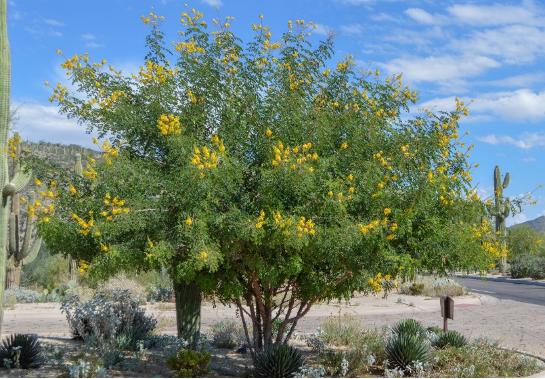7 Desert Trees to Consider When Designing Your Arizona Landscape
If you’re searching for a way to add shade, color, or curb appeal to your Arizona yard, planting desert trees is a great way to achieve the low-maintenance beauty you’ve been desiring.
From large, evergreen trees and small, deciduous trees to fragrant purple blooms to small yellow flowers, this list has a tree for every type of desert landscape.
Here are some popular desert trees to consider for your Arizona landscape!
1. Desert Ironwood Tree
The Ironwood tree is a plant native to Arizona, and it’s known for its dense and heavy wood. When it reaches full maturity, the Ironwood tree grows to be 30’ x 30’.
The branches of the Ironwood tree offer the perfect evergreen screen against unsightly views, and it provides a significant amount of cooling shade as it grows. Though this tree grows slowly, the wait is worthwhile. Eventually, the Ironwood tree grows medium-sized with strong branches and a solid, gray trunk.
This tree blooms with beautiful pale pink flowers in the late spring and fall. Though it can tolerate direct sunlight, as it grows, the Ironwood tree may need protection from the harsh winter temperatures until it reaches full maturity and is well-established in the landscape.
2. Desert-Willow Tree
Desert-willow trees are native to the southwestern United States and northern Mexico. When it reaches full maturity, the desert-willow tree grows to be 25’ x 25’.
This small, deciduous tree has narrow, bright green leaves, willow-like foliage, and colorful trumpet-shaped flowers. In the colder months, the desert-willow tree loses its leaves, but in the summer, its blooms rival the beauty of all other desert trees. Desert-willow trees typically display pale pink or lavender flowers when they’re in bloom.
3. Palo Brea Tree
The Palo Brea tree, also known as the Sonoran palo verde, is a small, fast-growing tree that reaches a mature size of 30’ x 30’. Palo Brea trees are native to Mexico, Columbia, Peru, Venezuela, and Ecuador, and they are part of the palo verde tree family.
In Southern Arizona, the Palo Brea is a popular shade tree because of its wide, open, and spreading crown. This deciduous, drought-tolerant tree is perfect for low-desert gardens and xeriscapes, and the twisting gray-green trunk offers eye-catching appeal.
Palo Brea trees bloom in the late spring with small, yellow flowers that cover the tree in axillary clusters. Light-brown seed pods follow the flowers in the early summer.
4. Texas Ebony Tree
Texas ebony trees are excellent shade trees for Southern Arizona. They stand at 30’ x 30’ when they reach full maturity.
Texas ebony trees love sunlight and are incredibly drought-tolerant, making them excellent desert trees. They grow at a slow rate and can be planted in small spaces. This tree blooms with cream-colored, fragrant clusters of flowers in the late spring and fall, followed by dark brown seedpods.
Texas ebony trees keep their dark green compound leaves all year, so you’ll constantly have shade, even during the cooler winter months.
5. Arizona Ash Tree
The Arizona ash is a fast-growing, deciduous tree native to California, Texas, and Arizona, and it also grows in Mexico. It's closely related to the Oregon ash tree.
Arizona ash trees produce large, leathery, dark green leaves divided into leaflets to form a dense, rounded canopy, making this tree ideal for residential landscapes. Before the leaves fall off the tree when the weather becomes cold, they turn bright yellow. The tree's white-green blooms are deciduous and bloom during the late spring.
6. Texas Mountain Laurel Tree
Texas mountain laurel trees are native to Texas and grow well in sunny, dry environments. These evergreen trees keep their leaves all year, and they grow slowly, so they’re great patio trees. They’re also small, just 15’ by 15’ when fully grown, so they won’t offer much shade.
Texas mountain laurel trees are best known for their vibrant, fragrant purple flowers that bloom in the spring, followed by clusters of black seedpods. Many people think the flowers smell like grape bubblegum! However, the blooms and seedpods are poisonous if ingested, so this tree may not be ideal for families with pets or small children.
7. Cascalote Tree
Cascalotes grow as large shrubs or small trees that can reach a mature size of 20' x 20'. This tree is native to southern Mexico and has adapted to hot, dry washes, mesas, and slopes, making it an excellent choice for Arizona landscapes.
This slow-growing, semi-deciduous tree blooms with spikes of yellow flowers in the cooler months, making it a great option to add vibrant color to your yard in the winter.
Design Your Dream Backyard with Wildflower Desert Design
If you're ready to add one (or more!) of these beautiful desert trees to your backyard landscape, allow our team at Wildflower Desert Design to help.
We can help you envision how your backyard landscape would look with realistic, professionally designed 3D renderings and then help direct you to the right contractors to complete the job with excellence. Contact us today for a free consultation!








